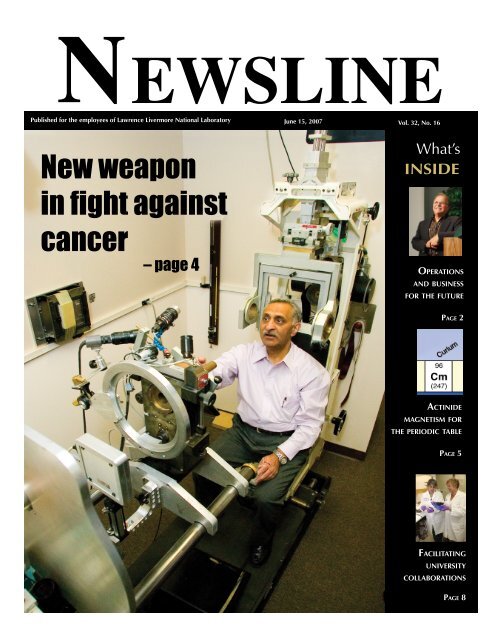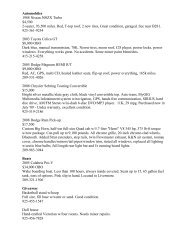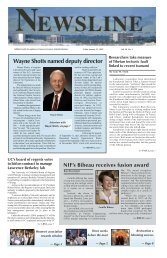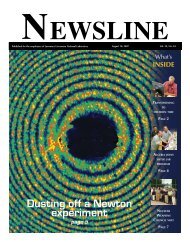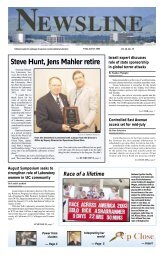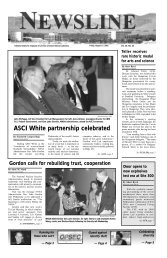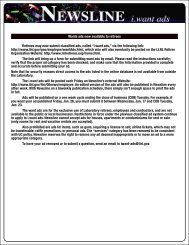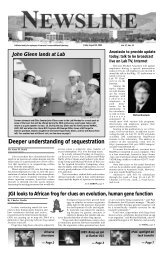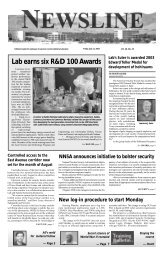NEWSLINE - Lawrence Livermore National Laboratory
NEWSLINE - Lawrence Livermore National Laboratory
NEWSLINE - Lawrence Livermore National Laboratory
Create successful ePaper yourself
Turn your PDF publications into a flip-book with our unique Google optimized e-Paper software.
<strong>NEWSLINE</strong><br />
Published for the employees of <strong>Lawrence</strong> <strong>Livermore</strong> <strong>National</strong> <strong>Laboratory</strong> June 15, 2007 Vol. 32, No. 16<br />
New weapon<br />
in fight against<br />
cancer<br />
– page 4<br />
What’s<br />
INSIDE<br />
OperatiOns<br />
and business<br />
fOr the future<br />
page 2<br />
actinide<br />
magnetism fOr<br />
the periOdic table<br />
page 5<br />
facilitating<br />
university<br />
cOllabOratiOns<br />
page 8
2 <strong>NEWSLINE</strong><br />
2007<br />
June 15, 2007<br />
TRANSITION NEWS<br />
New Operations and Business organization unveiled<br />
By Don Johnston<br />
Newsline staff writer<br />
In a town hall meeting Tuesday for what will be<br />
the Operations and Business Principal Directorate<br />
starting Oct. 1, Principal Associate Director Frank<br />
Russo introduced himself, his management team and the<br />
directorate’s basic structure.<br />
“This feels a lot like 37 years ago when I met my<br />
in-laws. I knew it was important and I knew it was the<br />
start of a process to become a part of the family,” Russo<br />
joked after he was introduced by <strong>Lawrence</strong> <strong>Livermore</strong><br />
<strong>National</strong> Security, LLC (LLNS) President George<br />
Miller.<br />
“The first thing I want to speak to is who I<br />
work for; I work for <strong>Lawrence</strong> <strong>Livermore</strong> <strong>National</strong><br />
<strong>Laboratory</strong>, not Bechtel…LLNS — yes they pay the<br />
bills — but LLNS is a ream of paper that establishes<br />
contractual relationships,” he said. “It’s an entity, it’s not<br />
flesh and blood and it’s not the body and soul that I’ve<br />
found in the first month I’ve been here. There’s nothing<br />
more impressive than a place where they take pride in<br />
what they do.<br />
“I work for <strong>Lawrence</strong> <strong>Livermore</strong> <strong>National</strong><br />
<strong>Laboratory</strong> first and foremost. LLNS, which is further<br />
down the page, is the entity that is going to provide<br />
the paychecks,” Russo said, explaining that this<br />
is not unusual for people, like him, who come out<br />
of companies such as Bechtel, Washington Group<br />
or BWXT and who spend their careers managing<br />
government projects or managing and operating<br />
government labs or facilities.<br />
“At the end of the day this LLNS organization will<br />
be satisfied only if it makes this <strong>Laboratory</strong> better than it<br />
already is,” he said.<br />
Russo recounted experiences from work on<br />
a variety of projects to highlight his beliefs and<br />
management style, which he summarized as: “brains not<br />
brawn; minds not backs; and evolution not revolution.”<br />
“Anyone can work crazy hours to get ahead. The<br />
trick is working so intelligently you don’t have to work<br />
crazy hours,” he said, noting that “when I came here I saw<br />
that working intelligently was a part of your culture.”<br />
The transition the <strong>Laboratory</strong> is undergoing is “an<br />
evolution,” Russo said, “and that means we’re going to<br />
listen before we act. We’re going through a process now<br />
where we’re starting to make some big connections, but<br />
all 8,000 connections to individual employees are going<br />
to take time.”<br />
Russo discussed the role of the O&B Principal<br />
Directorate and how it will, along with science and<br />
technology, support Lab missions and programs, a<br />
structure that was a “cornerstone” of the proposal<br />
submitted to the Department of Energy and that “DOE<br />
found to be very attractive.”<br />
The underpinning idea is “to eliminate redundancy<br />
and excessive requirements to create efficiencies<br />
— money and people — and transfer both from indirect<br />
support to mission work,” he said.<br />
Russo then went on to unveil the directorate’s<br />
organization, divided into four principal areas, and the<br />
leadership team: Dave Leary, deputy principal associate<br />
director for Operations and Business and associate<br />
director for Business; Tammy Jernigan, associate<br />
Frank Russo<br />
JACQUELINE MCBRIDE/<strong>NEWSLINE</strong><br />
director for Strategic Human Capital Management;<br />
Harold Conner, associate director for Facilities and<br />
Infrastructure; and Pam Horning, associate director for<br />
Nuclear Operations.<br />
Other organizations reporting directly to Russo<br />
are: Project Management; Institutional Facilities<br />
Management; LLNS/Los Alamos <strong>National</strong> Security<br />
Business Integration; the directorate’s chief of staff; and<br />
the principal associate director’s office.<br />
Russo explained that Strategic Human Capital<br />
Management and Business were being tied together<br />
in the new organization for better integration of<br />
services. “What we’re looking to do comes under the<br />
heading of ‘interface management.’ We have very<br />
good human resources, finance, procurement and some<br />
project control systems, but they’re not uniform and<br />
consistently applied and the interfaces are not fully<br />
connected,” he said. “We have a proposal element called<br />
Business Systems Process and Improvement Project<br />
where we’re going to look for and make the connections<br />
in those systems.”<br />
Interface management will help the Lab develop a<br />
“graded approach” to improve project controls, Russo<br />
said, noting “we’re keenly aware that one size does not<br />
fit all in a <strong>Laboratory</strong> environment. So as we go forward<br />
we’ll put the suite of tools together and then determine<br />
how they’re applicable to individual elements of work.”<br />
Principal directorate organization<br />
As associate director for Strategic Human Capital<br />
Management, Jernigan’s job will be to “work closely<br />
with core Lab missions and science and technology<br />
to ensure that we are recruiting and retaining the<br />
kinds of minds that have existed in this Lab for 54<br />
years,” Russo said. “We want to make sure that<br />
the demographics of today’s world and the natural<br />
attrition occurring as baby boomers age do not<br />
diminish the capability of this Lab.”<br />
He said the human resources services currently<br />
in the Administration and Human Resources<br />
Directorate will “move intact” into Strategic Human<br />
Capital Management.<br />
DOE/NNSA will hold LLNS accountable<br />
for initiatives contained in the contract proposal<br />
including “doubling the number of post docs,<br />
expanding leadership development processes and<br />
introducing performance-based leadership training,”<br />
he said. “HR also is going to play a big role in<br />
integrating the HR data that carries wage and costing<br />
information with our financial tools so we can get<br />
better accuracy.”<br />
Russo said business services will create, at a<br />
high level supply, chain management as opposed to<br />
the current system with various divisions performing<br />
procurement-related functions. “Supply chain<br />
management will be identification of the need<br />
through the final disposition of the excess material;<br />
cradle-to-grave accountability within one basic<br />
organization for purchasing, material distribution,<br />
property management and, ultimately, disposition.”<br />
Turning to other directorates, Russo said<br />
there’s a “natural link-up” between Facilities and<br />
Infrastructure and Nuclear Operations in what he<br />
termed “consistency management” — prescribed<br />
routines that have proven successful and with built-in<br />
improvement mechanisms. “Centralized conduct of<br />
operations and maintenance, and common training<br />
and work processes will provide that consistency.”<br />
The Facilities and Infrastructure Directorate<br />
will include emergency management, environmental<br />
restoration, infrastructure services and the project<br />
management that currently resides in Plant<br />
Engineering. Russo emphasized that environmental<br />
restoration would not just deal in typical ways with<br />
environmental issues, “but use our know-how to find<br />
better, more effective and safer ways to deal with<br />
environmental cleanup opportunities.”<br />
While many of the specifics about the Nuclear<br />
Operations Directorate are being worked out, Russo<br />
said that it is being organized on the principle of “line<br />
accountability” consistent with DOE’s Integrated<br />
Safety and Security Management requirements.<br />
In its contract proposal, LLNS committed<br />
to integrating business systems with Los Alamos<br />
<strong>National</strong> Security for improved collaboration and cost<br />
efficiencies, such as through common procurements,<br />
Russo said, explaining the creation of the LLNS/<br />
LANS Business Integration Office.<br />
Russo concluded by outlining his commitment<br />
to employees: “I’ll work with you to make the Lab<br />
more effective, introduce best practices and new<br />
tools only if those add value. We’ll continue to<br />
listen. I don’t have all the answers today. We need<br />
to work together and I need every one of you in my<br />
directorate and everyone in the support organizations<br />
to help deliver on the promise we made to NNSA to<br />
keep this <strong>Laboratory</strong> at the very top of science and<br />
technology.”<br />
The complete town hall presentation and<br />
viewgraphs are available on the Transition Website:<br />
http://transition.llnl.gov/home/
June 15, 2007<br />
2007<br />
TRANSITION NEWS: Realigning the <strong>Laboratory</strong><br />
In my column last week, I wrote about the “people”<br />
phase of the LLNS transition.This includes LLNS<br />
listening and learning about our <strong>Laboratory</strong> and a<br />
chance for our directorates to hold “colleague-level”<br />
discussions with the LLNS management team. As<br />
you are aware, each of the LLNS principal associate<br />
directors (PAD) is holding “town hall” meetings<br />
through the rest of this month to familiarize employees<br />
with their evolving organizational vision and structure.<br />
These town halls also provide employees with an<br />
opportunity to ask questions. This week we heard from<br />
Frank Russo regarding Operations and Business (see<br />
accompanying story, page 2).<br />
In parallel with these “listening and learning”<br />
discussions, LLNS has begun the task of aligning<br />
our existing organization to the LLNS organizational<br />
structure. Realigning our <strong>Laboratory</strong> is an iterative,<br />
multi-step process that will include our workforce<br />
being “mapped,” or placed into the new LLNS<br />
organization. This process is an integral step for<br />
LLNS’ preparation of offer letters that will go to all<br />
UC employees in good standing in mid-July.<br />
During the process of realignment, several<br />
scenarios will play out:<br />
• Some new organizations will be created.<br />
• Some existing organizations will be<br />
consolidated.<br />
Transition focus<br />
Upcoming retirement sessions<br />
The Benefits Office will resume half-day<br />
retirement election preparation sessions in July<br />
for those considering retirement in calendar<br />
year 2007. These sessions have been created to<br />
provide necessary information to participants<br />
who will retire from the University of California<br />
Retirement Plan.<br />
Participants should sign up for sessions<br />
no more than 90 days in advance of their<br />
anticipated retirement date. Those who wish<br />
to attend must register using LTRAIN and<br />
refer to course PS8026. Upon completion<br />
of the retirement session, an appointment<br />
will be scheduled for participants to meet<br />
with retirement counselors to complete their<br />
retirement election.<br />
In order to ensure that employees will be<br />
able to schedule an appointment with minimum<br />
delay, the Benefits Office has arranged for<br />
retirement counselors to be available from other<br />
UC campuses to assist as needed.<br />
MAY<br />
Contract awarded<br />
to LLNS<br />
Transition planning<br />
begins<br />
JUNE JULY<br />
AUGUST<br />
LLNS town hall<br />
meetings<br />
Mapping process<br />
begins<br />
Benet planning<br />
under way<br />
PEOPLE<br />
Mid July: LLNL<br />
employees receive job<br />
oer letters<br />
2007 CONTRACT TIMELINE<br />
June 19 Weapons and Complex Integration,<br />
Bruce Goodwin, 1:30 p.m.<br />
June 21 Global Security,<br />
a message<br />
John Doesburg, 1:30 p.m.<br />
June 26 Science and Technology,<br />
Cherry Murray, 10 a.m.<br />
June 26 <strong>National</strong> Ignition Facility and<br />
Photon Science, Ed Moses, 11 a.m.<br />
June 28 Director’s Offi ce,<br />
tO emplOyees<br />
– Barbara Peterson<br />
• Most organizations will remain consistent with<br />
their existing structure.<br />
Many of you have asked what process LLNS<br />
will use to align the organizations, map the existing<br />
workforce and make decisions about hires or transfers<br />
into newly created positions or vacated positions<br />
due to retirements. Here is a summary of the process<br />
LLNS is using.<br />
The first step is to align our existing administrative<br />
organization to the proposed LLNS organization by<br />
moving organizational units, with the accompanying<br />
workforce, under the new appropriate PAD<br />
organization or to the Director’s Office. For example,<br />
we heard this week that LLNS Principal Associate<br />
Director for Operations and Business Frank Russo<br />
intends to move the Technical Information Department<br />
(TID), which is currently in the Administration and<br />
Upcoming town hall meetings<br />
George Miller, 1:30 p.m.<br />
Facility<br />
walk-throughs<br />
begin<br />
SEPTEMBER<br />
Lab policies and<br />
procedures formally<br />
reviewed<br />
Current LLNL<br />
contract expires<br />
PLACES<br />
PROCESSES<br />
Vacation cash-out letter<br />
<strong>NEWSLINE</strong> 3<br />
Human Resources Directorate (AHRD), into the<br />
Business Directorate under Dave Leary. Employees<br />
currently in TID will continue to work in TID, but<br />
under a new organization construct. This scenario is<br />
representative of how many of our organizational units<br />
will be aligned and the workforce mapped.<br />
The LLNS plan also calls for consolidating some<br />
existing organizations. In this scenario, some current<br />
positions may be eliminated or rolled into the new<br />
LLNS organization. In those cases, affected employees<br />
will be discussed and reviewed extensively with the<br />
current management team and the LLNS team to<br />
ensure appropriate placement for all employees.<br />
We also know that LLNS is creating some new<br />
organizational units. We heard from Frank Russo that<br />
he is creating a PAD office. In this case, new positions<br />
are being defined.<br />
This process of aligning organization units will be<br />
reviewed and iterated as needed based on a LLNS key<br />
personnel study of the winning proposal; information<br />
from the colleague-level briefings; comments received<br />
from the town hall meetings; feedback from the<br />
current LLNL leadership, and discussion among the<br />
LLNS senior management team.<br />
The LLNS team also will pay attention to<br />
vacancies created by retirees and positions that are<br />
See TRANSITION, page 8<br />
On Thursday, June 21, the LLNL Payroll Office<br />
will mail information (via U.S. mail) to all employees<br />
regarding vacation cash-out options. Look for an<br />
envelope marked “Transition information, open<br />
immediately.” For employees continuing employment<br />
with LLNS effective Oct. 1, the letter will explain<br />
choices: to either cash out their UC vacation balance<br />
in full, or carry over their accrued vacation hours to<br />
LLNS. No partial cash-outs or carry-overs will be<br />
allowed. A vacation cash-out calculator is available on<br />
the <strong>Livermore</strong> Payroll Website (https://www-cfo.llnl.<br />
gov/organization/ad/pr/) to help estimate cash-outs<br />
and potential tax impacts; however, employees are<br />
urged to weigh their options carefully and discuss<br />
potential tax consequences with their tax advisers<br />
or the Internal Revenue Service. All employees<br />
must make their election by Aug. 30. An online<br />
election form will be available on the <strong>Livermore</strong><br />
Administrative People Information System (LAPIS)<br />
(http://www-r.llnl.gov/lapis/). Questions may be<br />
addressed to the Payroll office at 2-9132.<br />
OCTOBER<br />
New LLNL<br />
contract begins.
4 <strong>NEWSLINE</strong><br />
June 15, 2007<br />
SCIENCE NEWS<br />
Making proton therapy more accessible to cancer patients<br />
By Claudia Morain<br />
UC Davis News Service<br />
With a technology transfer<br />
agreement announced Thursday, the<br />
first compact proton therapy system<br />
— one that would fit in any major<br />
cancer center and cost a fifth as much<br />
as a full-scale machine — is one step<br />
closer to reality.<br />
Proton therapy is considered<br />
the most advanced form of radiation<br />
therapy available, but size and cost<br />
have limited the technology’s use to<br />
only six cancer centers nationwide.<br />
The result of defense-related<br />
research, the compact system<br />
was developed by scientists at the<br />
<strong>Laboratory</strong> in a project jointly funded<br />
by the Lab and UC Davis Cancer<br />
Center. In the new technology<br />
transfer pact, LLNL has licensed<br />
the technology to TomoTherapy<br />
Incorporated (NASDAQ: TTPY) of<br />
Madison, Wis., through an agreement<br />
with the Regents of the University of<br />
California.<br />
TomoTherapy will fund<br />
development of the first clinical<br />
prototype, which will be tested on<br />
patients at UC Davis Cancer Center.<br />
If clinical testing is successful,<br />
TomoTherapy will bring the machines to market.<br />
“We are very pleased that the basic research of our<br />
department’s defense scientists also may serve the nation<br />
by helping to make proton therapy more available to<br />
cancer patients,” said Raymond Orbach, the Department<br />
of Energy’s under secretary for Science.<br />
“This technology has grown out of work to develop<br />
compact, high-current accelerators as flash X-ray<br />
radiography sources for nuclear weapons stockpile<br />
stewardship,” said George Caporaso, the lead scientist<br />
on the project at the <strong>Laboratory</strong>. “We are excited about<br />
applying this new technology to the field of cancer<br />
treatment, to make proton therapy widely available as a<br />
treatment option.”<br />
“We have taken proton therapy and achieved major<br />
advances toward what we were told was impossible — to<br />
scale it down to a size and price that will bring it in reach<br />
of every major cancer center,” said Ralph deVere White,<br />
director of the UC Davis Cancer Center and associate<br />
dean for cancer programs. “Our research partnership<br />
with <strong>Lawrence</strong> <strong>Livermore</strong> <strong>National</strong> <strong>Laboratory</strong> has<br />
fulfilled the mission for which it was created: to deliver<br />
translational research in order to advance health care.”<br />
Conventional radiation therapy kills cancer cells<br />
using high-energy X-rays. These X-rays deliver energy<br />
to all the tissues they travel through, from the point they<br />
enter the body, until they leave it. Doctors therefore have<br />
to limit the dose delivered to the tumor to minimize<br />
damage to surrounding healthy tissue.<br />
Unlike high-energy X-rays, proton beams deposit<br />
almost all of their energy on their target, with a low<br />
amount of radiation deposited in tissues from the surface<br />
of the skin to the front of the tumor, and almost no “exit<br />
dose” beyond the tumor. This property enables doctors<br />
to hit tumors with higher, potentially more effective<br />
radiation doses than is possible with gamma radiation.<br />
Ralph deVere White (right), director of the UC Davis Cancer Center; Peter Hoban (left),<br />
senior product manager for TomoTherapy Incorporated; and Bill Goldstein, associate director<br />
for Physics and Advanced Technologies at LLNL, announced a technology transfer pact<br />
that would produce the fi rst compact proton therapy system to treat cancer patients during<br />
a press conference Thursday at UC Davis. The compact system would fi t in any major cancer<br />
center and cost a fi fth as much as a full-scale machine.<br />
“Until proton therapy is more common and we<br />
can do large comparative studies, we can’t say with<br />
specificity what the impact will be on survival and other<br />
treatment outcomes,” said deVere White, a urologic<br />
oncologist. “However, we expect that outcomes will be<br />
significantly better. As with other advances we have seen<br />
in cancer, this will reset the norm of what constitutes best<br />
therapy.”<br />
One of the largest studies of proton therapy,<br />
published in the June 1, 2004, issue of the International<br />
Journal of Radiation and Oncology, looked at 1,255 men<br />
who were treated for localized prostate cancer during the<br />
1990s at the Loma Linda University Medical Center’s<br />
Proton Treatment Center in Loma Linda, Calif. The<br />
study concluded that proton therapy yielded diseasefree<br />
survival rates comparable to those of surgery or<br />
conventional radiation, but with minimal to no side<br />
effects, such as incontinence and impotence.<br />
Charged protons were first used in the successful<br />
treatment of human cancer in experiments at the<br />
Berkeley Radiation <strong>Laboratory</strong> more than 50 years ago.<br />
But because the machines can cost more than $100<br />
million to build and can require 90,000 square feet to<br />
house, today only six centers in the United States offer<br />
proton treatment: Loma Linda, Massachusetts General<br />
Hospital’s Francis H. Burr Proton Therapy Center in<br />
Boston, Anderson Cancer Center’s Proton Therapy<br />
Center in Houston, Midwest Proton Radiotherapy<br />
Institute in Bloomington, Ind., and the University of<br />
Florida Proton Therapy Institute in Jacksonville. In<br />
addition, UC Davis Cancer Center offers proton therapy<br />
for ocular melanoma only.<br />
Worldwide, there are 25 proton therapy centers<br />
in operation. Together, they have treated an estimated<br />
40,000 patients.<br />
The compact system is expected to fit in standard<br />
radiation treatment suites and to cost less than $20<br />
million. The compact system will be<br />
mounted on a gantry that rotates about<br />
the patient.<br />
Caporaso’s team overcame<br />
the size obstacle by using dielectric<br />
wall accelerator technology<br />
developed through defense research.<br />
The <strong>Livermore</strong> scientists have<br />
demonstrated in principle that this<br />
technology will enable proton particles<br />
to be accelerated to an energy of at<br />
least 200 million electron volts within<br />
a light-weight, novel, insulator-based<br />
structure about 6.5 feet long. It also<br />
won’t use any bending magnets, and<br />
will be able to change the protons’<br />
energy and intensity between each<br />
burst that occurs many times per<br />
second.<br />
Currently available proton<br />
therapy machines use cyclotrons or<br />
synchrotrons nearly 10 feet in diameter<br />
and weighing up to several hundred<br />
tons. This equipment includes the<br />
enormous gantry and bending magnets<br />
necessary to focus and direct the<br />
beams on to patients.<br />
In addition to overcoming size and<br />
cost obstacles, the compact system will<br />
improve on existing full-scale systems<br />
by including the capability to vary<br />
the energy, intensity and “spot” size<br />
of the proton beam. Radiation will be produced in rapid<br />
pulses, creating small “spots” of dose throughout the<br />
tumor. Currently only one proton facility in the world, the<br />
Paul Scherrer Institute in Switzerland, is able to deliver<br />
this intensity-modulated proton therapy (IMPT). IMPT<br />
is generally considered the best way to destroy tumors<br />
while minimizing damage to surrounding healthy tissue.<br />
TomoTherapy was established to commercialize<br />
another radiation therapy advance developed by<br />
university researchers, the Hi-Art® treatment system.<br />
That system, which marries a CT scanner to a state-ofthe-art<br />
linear accelerator, was developed by Thomas<br />
“Rock” Mackie and Paul Reckwerdt at the University of<br />
Wisconsin.<br />
“We look forward to partnering with <strong>Lawrence</strong><br />
<strong>Livermore</strong> to commercialize this technology for such a<br />
great cause,” said Reckwerdt, co-founder with Mackie of<br />
the company. “Proton therapy has recognized advantages<br />
in the treatment of many cancer sufferers and we hope to<br />
be able to make it widely available.”<br />
JACQUELINE MCBRIDE/<strong>NEWSLINE</strong><br />
On the cover: Inder<br />
Daftari, a medical<br />
physicist at UC San<br />
Francisco, shows how a<br />
patient with melanoma<br />
of the eye would receive<br />
proton beam therapy<br />
at the Crocker Nuclear<br />
<strong>Laboratory</strong> at UC Davis.<br />
In the future, a proposed<br />
compact proton therapy<br />
machine would make this treatment much<br />
more accessible to cancer patients.
June 15, 2007<br />
<strong>NEWSLINE</strong> 5<br />
Gaining periodic stability through magnetism<br />
By Anne M. Stark<br />
Newsline staff writer<br />
Researchers have a better understanding<br />
of how the crystal structure of some metals<br />
becomes stable through magnetism.<br />
Magnetic stabilization of the crystal<br />
structures of metals is rare. In some metals,<br />
such as manganese, iron and cobalt, the<br />
magnetic interaction energy is large enough<br />
to influence the crystal structure.<br />
However, recent research shows that<br />
magnetically stabilized crystal structures<br />
also include the heavy actinide element,<br />
curium (Cm). In a diamond-anvil cell study,<br />
Cm was pressurized up to one million<br />
atmospheres of pressure, which caused the<br />
metal to undergo transformations between<br />
five different crystal phases.<br />
But a new study by <strong>Livermore</strong> scientists<br />
goes one step further. The team, made up<br />
researchers from <strong>Lawrence</strong> <strong>Livermore</strong><br />
and Oak Ridge national laboratories<br />
and Daresbury <strong>Laboratory</strong> in the United<br />
Kingdom, probed the electronic and<br />
magnetic structure of Cm by using electron<br />
energy-loss spectroscopy (EELS) in a<br />
transmission electron microscope (TEM),<br />
electron atomic calculations and density<br />
functional theory (DFT). To date, absorptiontype<br />
experiments have not been performed<br />
on americium (Am) or Cm.<br />
“Our results for curium go a long way in<br />
teaching us a general understanding of how<br />
this mechanism occurs,” said Kevin Moore,<br />
the LLNL lead author of the research paper<br />
that appears in the June 8 issue of the journal<br />
Physical Review Letters. Other <strong>Livermore</strong><br />
researchers include Mark Wall, Adam<br />
Schwartz and Per Söderlind as well as Gerrit<br />
van der Laan from Daresbury and Richard<br />
Haire from Oak Ridge.<br />
The Hund’s rule coupling is the key to<br />
producing the large spin polarization that<br />
dictates the newly found crystal structure of<br />
Cm under pressure.<br />
Hund’s rule of maximum spin<br />
multiplicity is a principle of atomic<br />
chemistry, which assumes that a greater<br />
total spin state usually makes the resulting<br />
SCIENCE NEWS<br />
The elements from<br />
actinium (element 89)<br />
to lawrencium (element 103)<br />
form a distinct group<br />
— the actinides —<br />
within the periodic table.<br />
atom more stable, most commonly exhibited<br />
in a lower energy state, because it forces<br />
the unpaired electrons to reside in different<br />
spatial orbitals. By staying out of each others<br />
way, the electrons lower their total energy.<br />
“This gives us great insight into<br />
the valence state and electron coupling<br />
mechanisms of 5f electrons in plutonium and<br />
americium, two metals that are significant to<br />
nuclear reactors,” Moore said. “Our data will<br />
help us refine our theoretically predictive<br />
codes for these metals to give us a better<br />
understanding of the physical properties of<br />
the metals and how they will behave under<br />
extreme conditions.”<br />
The <strong>Livermore</strong> research also helps fill<br />
a gap in a recent Nature paper (446, page<br />
513, 2007) from Rutgers University that had<br />
a missing data point in a table. The LLNL<br />
americium and curium data fill the blank<br />
space in the table.<br />
“The two papers (PRL and Nature)<br />
greatly further our understanding of the<br />
middle actinide metals — plutonium,<br />
americium and curium,” Moore said.
<strong>NEWSLINE</strong> June 15, 2007<br />
i.want ads<br />
autOmObiles<br />
1986 Ford Thunderbird. $800. Runs<br />
well. 925-684-2320 or 925-437-0428.<br />
1990 Corvette. $7,500 coupe, black, 5.7<br />
liter, auto, 68K miles. 925-449-7651<br />
1991 Ford E-150 van. $2,000. V8, AC,<br />
TV, VCR, fridge, sink, rear seat folds to<br />
bed, 88k miles 925-455-6523<br />
1993 Lexus. $4,200, ES300, black,<br />
140K miles. 925-998-0805<br />
1996 Chevy Blazer. $2,300. Black, 4<br />
door, 2WD, Vortec V6 190hp, 215k<br />
miles original motor. 209-835-5851<br />
1997 Plymouth Breeze. $4,000,<br />
71,000 miles. 925-454-1518<br />
2000 Subaru Outback Limited Edition.<br />
$8,990. 137K highway miles. 925-371-<br />
1854<br />
2002 Cabrio VW GLX. $11,950. 61K<br />
miles, 925-960-1648<br />
2006 BMW M3 coupe. $52K obo.<br />
Titanium Slv/Blk Lthr 4.9km SMG 6spd<br />
925-820-4515<br />
Lexus ES300. 2001, $17,700, 87K mi,<br />
209-518-2156<br />
New tire. $75 OBO, mounted,size 205<br />
X 75 X l5 925-735-6002<br />
1998 red Mustang convertible. $7,500,<br />
925-371-8111<br />
bicycles<br />
26” Schwinn bicycle. $30. Black<br />
Frontier mens’, 925-443-7531<br />
bOats<br />
2005 Reinell 203. $20,500 OBO. 925-<br />
240-0597 or 925-584-1612<br />
2005 Sanger Boat. V215, $37,000. 25<br />
engine hours. 925-373-3312<br />
Paddle boat. $450 OBO. 925-516-8925<br />
electrOnic equipment<br />
27 inch Sony TV w/ stand. $125. Cable<br />
ready. 925-606-6954<br />
AT&T/Cingular 8525. $400. 209-915-5777<br />
Dell 2000fp monitor. $150 obo. 925-<br />
449-4341<br />
LaCie external CD burner. $50 Firewire<br />
400 for Mac and PC 925-443-4292<br />
Cherry wood Hitachi stereo cabinet.<br />
$20. 925-964-0534<br />
giveaway<br />
17” COMPAQ color monitor. Must<br />
pick up. 925-449-2620<br />
Brass and glass chandelier. 925-455-9125<br />
Conn Prelude electric organ. Free, you<br />
haul. 209-601-2962<br />
Glass table top. 82x43” 3/4” thick,<br />
tempered glass, beveled edge. Base<br />
and chairs long gone. Must pick up.<br />
925-449-4341<br />
<strong>National</strong> Geographic magazines. 1970’s &<br />
1980’s. Free. 925-215-1618<br />
36” Sliding white aluminum patio<br />
screen door. 925-443-9052<br />
Small color TV. Works but not cableready.<br />
925-426-9886<br />
Twin trundle. Mattress not included.<br />
You haul. 925-455-4666<br />
Weight bench. Will deliver if in<br />
<strong>Livermore</strong>. 925-606-9402<br />
hOusehOld<br />
Baby Trend Sit ‘n Stand double stroller.<br />
$75. 925-997-1568<br />
Beautiful solid wood display shelves.<br />
$145. Overall dim. 15”D x 72”H,<br />
13lbs. Prices are firm. 925-640-5469<br />
Brass king size headboard. $100 OBO.<br />
373-1522<br />
Built-in dishwasher. $75 Kenmore 665.<br />
24” black finish. 925-398-0545<br />
Serta Grand Sonata Cal king mattress.<br />
$200 obo. 925-443-8354<br />
Cherry wood dining table w/leaf & 6<br />
chairs. $250. 209-483-6278<br />
Walnut desk. $45. 36” X 70” 30.5”<br />
high. One drawer, on casters. 925-<br />
245-9648<br />
Glass and travertine dining set. $500. 6<br />
chairs and side table. 925-606-9402<br />
Antique dining table. $400 8 chairs.<br />
Missing leaf. 925-454-1478<br />
Dishwasher. $200 OBO. Maytag<br />
Jetclean II QuietSeries. White. Width:<br />
23-7/8”-Height: 33-1/2”-Depth: 19-<br />
1/2” 510-792-1538<br />
Honey maple entertainment center.<br />
$150 OBO. Holds 32” TV. 510-792-<br />
1538<br />
Bedroom armoire. $30. Crib $50, 3 blk<br />
bar stls $25, white ktch cabinet $10, Lt<br />
oak TV stnd $30, 209-832-4576<br />
Fully furnished doll house. $30. 925-<br />
606-9781<br />
Hot water heater. $100. Propane. 925-<br />
447-7255<br />
Hanging stained glass kitchen lamp.<br />
$75. 20” diam by 12” tall shade. Pink,<br />
green, white, and clear hummingbird<br />
motif. 925-398-0545<br />
Rattan table and 6 chairs. $150. Glass<br />
top table, 48” diameter. 925-373-7025<br />
Brown fabric recliner. $200 OBO. 510-<br />
792-1538<br />
Stove, refrigerator, washing machine<br />
and furniture. Excellent prices. 925-<br />
353-0157<br />
Small black wooden three-shelf<br />
bookcase. $10. 27” w x 36” h. 925-<br />
413-2595<br />
Henredon sofa/coffe table. $1,500/650.<br />
3 piece sectional beige/ecru/gold, glass<br />
top wood coffee table w/pedestal base.<br />
925-634-7573<br />
Solid oak twin bedroom set. $495<br />
OBO. Includes trundle bed, 2<br />
mattresses, bookcase, headboard and<br />
armoire. 925-243-9123<br />
Maytag Washer/Kenmore Dryer. $75<br />
washer, $25 dryer. 925-443-3883<br />
lOst and fOund<br />
Found: ladies coin bag in lab bike<br />
basket 6/7/07 near Bldg. 490. 925-<br />
625-4806<br />
miscellaneOus<br />
2 baby bouncy seats. $8. 925-371-0585<br />
A’s/Cardinals field level tickets. 4 tickets<br />
to 2 games ($28 each - face value).<br />
Due to the high quantity of ads and space limitations, these want ads have been abbreviated.<br />
For the complete ad listings, refer to the internal Website: http://www-r.llnl.gov/pao/news/ wantads.html or for the latest pdf download and retiree<br />
information, see the external Website: http://www.llnl.gov/pao/employee/. Please note that these ads appear on the Web.<br />
Date of ads: Approx. June 6 to June 12. Ads appear on the Web for seven days.<br />
6/15, 6/16. Section 105, Row 4. 408-<br />
242-5581<br />
Baby items. $20-40. 925-373-6833<br />
Barbie electronic guitar. New in<br />
unopened box. 925-648-0671<br />
Baseball bat aid. $30. For ages 7 and<br />
up. 925-648-0671<br />
Car seat base and Baby Bongo chair.<br />
$20/each. Call after 5 p.m. 924-449-<br />
4981<br />
Garage/moving/estate sale. Saturday,<br />
6/16, 8 a.m - 3 p.m., Sunday, 6/17,<br />
from 8 a.m. - noon. 2437 Harewood<br />
Dr., <strong>Livermore</strong>. 925-853-4649<br />
Giant gumball machine. $475 OBO.<br />
925-516-8925<br />
George F. Crane Company Globe, $10,<br />
12-inch-diam. 925-245-9648<br />
Graco SnuggleRide snap-in car seat,<br />
stroller and 3 bases. $75. 925-371-0585<br />
Soccer ball-shaped humidifier. $15. 1<br />
gallon. 925-648-0671<br />
Looking for pilots/aviators for new<br />
LLESA group. 925-323-8223<br />
Model skeleton. $35. 925-245-9648<br />
Nikon FE-2 35mm camera, lens. $190.<br />
Manual 35mm. 925-443-8191<br />
Polaris pool sweep. $100/obo. 373-1522<br />
Shopsmith Mark V. $3,500. 925-373-6833<br />
Suburban tires and wheels. $100. Best<br />
offer or trade. 925-373-3429<br />
1 Ticket to Los Lonely Boys Concert. $50.<br />
Wente Vineyards on Aug. 16. 925-846-3278<br />
mOtOrcycles<br />
2000 Honda 929 CBR. $3,900. 7,400<br />
miles. 925-443-8191<br />
2006 Kawasaki KLR 650. $4,800. Dualsport<br />
bike. 925-321-6741<br />
96 Dyna Glide Harley. $10,000. Blue<br />
and chrome. 209-858-1209<br />
2005 Honda CRF 250X. $4,250 OBO.<br />
925-337-2875<br />
88 Suzuki 305 LTD Sportster. $450<br />
OBO. 408-263-2846<br />
musical instruments<br />
1903 Chickering upright studio piano.<br />
$2,500 OBO. 925-634-9973<br />
Didgeridoo. $50. Australian, key of D#,<br />
painted. 925-634-2701<br />
Guitars. Gibson S.G., $850; American<br />
Fender Stratocaster, $750. Both with gig<br />
bags. Call 209-351-0631<br />
Yamaha Spinet Piano. $750.<br />
Metronome included. 510-653-1017<br />
Pets<br />
Cat needs a good home. Free. She is<br />
a long hair, domestic, 4-5 years old,<br />
house broken and very loving. 209-<br />
521-0747<br />
Cavalier King Charles Spaniel pups.<br />
Male: ruby; female: black and tan.<br />
Ready June 29. ACA registered. 650-<br />
714-1612<br />
Dog Kennel. $75. approx. 5x5x3.5<br />
Dogs up to 60 lbs. 925-373-3429<br />
Female English bulldog. $700. AKC,<br />
brindle w/little bit of white. 7 months<br />
old. 925-813-2597<br />
Palomino for sale. $2,000. 17 yrs. old<br />
gelding. Call after 5 p.m. 209-239-2812<br />
Large bird cage. $225. 5 ft tall, on<br />
stand with wheels 925-437-0428 or<br />
925-684-2320<br />
Siamese cat needs a good home. 11<br />
years old and does not like other cats.<br />
Quite sociable with people, great<br />
company. 925-484-3889<br />
recreatiOn equipment<br />
40 lb. XVest Fitness Vest w/ weights.<br />
$60. 925-413-2595<br />
New 2007 Burton Titan travel golf<br />
cover. $75. 925-829-9443<br />
Fly fishing float tube. $25. 925-634-2701<br />
Flexiciser for people with a disability.<br />
Best offer. 510-653-1017<br />
Metolius Bouldering crash pad. $60.<br />
925-413-2595<br />
New Ben Hogan Big Ben putter. $75,<br />
925-829-9443<br />
Nikon 16mm, fisheye f2.8 lens. $400.<br />
Manual focus 925-443-4292<br />
NordicTrack CXT 980 elliptical trainer.<br />
$300 OBO. 925-413-2595<br />
Scuba dive tanks. 2 aluminum. Good<br />
condition. You pick up. 925-416-1146<br />
Weight machine. $100. Dynamics<br />
LM9000 home gym. 925-846-1453<br />
ridesharing<br />
Carpool/Vanpool Roseville/N.<br />
Sacramento area. Work schedule<br />
MTWRF, 7-4 (flexible). Share driving.<br />
3-3203 or 831-210-3315<br />
From Tracy, flexible hours. 209-221-7836<br />
shared hOusing<br />
House exchange: <strong>Livermore</strong> for Kihei,<br />
Maui. Available: 8/1/2007. 3 BR, 2BA,<br />
in Kihei, Maui, Hawaii. 808-283-8239<br />
Room and private bath in <strong>Livermore</strong><br />
home. $650. Utilites included. In<br />
Springtown, 3 miles from Lab. 925-<br />
548-1868<br />
Room for rent. $775/mo. Pleasanton.<br />
Private bath, utilities included. 15-min.<br />
commute. (H);925-209-8778(C) 925-<br />
736-9009<br />
Room for rent-Tracy. $500/mo. PG&E<br />
is split 3 ways. $500 deposit and $500<br />
month. 925-337-3789<br />
Shared furnished apartment - <strong>Livermore</strong><br />
$750/mo 3 blocks from Lab. Available<br />
starting July 15. 916-797-1750<br />
Shared housing. $625 - Avail. July 1.<br />
Room w/own bathroom in <strong>Livermore</strong><br />
home. Rent includes util (except<br />
internet). Min 6 mos. Call 925-785-<br />
0189 to discuss.<br />
trailers<br />
2005 Weekend Warrior toy hauler.<br />
$25,000 FS3000, 510-566-8404<br />
2006 Forest River Cherokee 5th wheel.<br />
$23,000. Mid profile, 31.5 feet long.<br />
209-321-1506<br />
Trailers. $100. load leveler and sway<br />
control 10,000 lb. 209-747-6334<br />
trucks<br />
1998 Dodge 1500 Quadcab. 4X4.<br />
$9,999. 925-876-5588<br />
2003 Chevy Silverado, LS 1500,<br />
extended cab. $16,000. 35K miles.<br />
209-234-2337<br />
2003 GMC V6 Sonoma extended cab<br />
pickup. $9,800. 65,000 Mi.OBO. 925-<br />
373-1522<br />
2006 Chevy Silverado. BO. 3/4ton,<br />
crew cab short-bed, 8.1 liter (496cid)<br />
gas engine, 12,000 miles, 925-634-<br />
5851<br />
2002 GMC Yukon XL. $15,700 OBO.<br />
925-240-0597 or 925-783-0473<br />
2003 Dodge Dakota quad. $10,500.<br />
69k V8 Magnum 4.7 liter, automatic<br />
2WD 925-784-0633<br />
1986 K5 Jimmy/Blazer. 1986 89k. 23”<br />
rims- will sell w/ rims for 4,500 obo or<br />
3,500 obo w/ 33” tires. 925-487-4974<br />
2002 4X4 GMC Z71. $16,000 OBO.<br />
58,000 miles. 209-832-5462<br />
1995 4x4 Chevy Tahoe. $4,500 OBO.<br />
209-740-2506<br />
vacatiOn rentals<br />
Arnold area mountain home. 1,600 sq.<br />
ft. 4 BR 2 BA home 925-245-1114<br />
Kona Big Island Hawaii Vacation<br />
Home. 2,300 sq. ft., 5 BR/3 BA; sleeps<br />
12 people. 415-377-5361<br />
Maui, HI Kahana Reef oceanfront<br />
1BR/1BA condo. 925 449 0761<br />
Mountain cabin. $225/wknd Pinecrest<br />
Lake area. 3 BR/2 BA 925-449-5513<br />
Santa Cruz beach house. 2 BR 2 BA,<br />
spa. 925-245-1114<br />
South Lake Tahoe chalet. Lab rates. 3<br />
BR 2 BA. 209-599-4644<br />
Tahoe Rental. $770/week or $100/<br />
night. Sleeps 8. 925-556-9511<br />
Truckee/ Tahoe home. 3 BR/2 BA,<br />
sleeps 8+, 925-784-0245<br />
Tahoe vacation home. $125. 3BR/2BA<br />
in Tahoma, sleeps 6-8. 925-813-2597<br />
Wine country rental. Monte Rio/<br />
Russian River. 3 BR, 1.5 BA, sleeps 6.<br />
925-513-4767<br />
wanted<br />
Display case. Cheap. Glass or plastic,<br />
408-263-2846<br />
Golf clubs for right-handed teenager.<br />
925-426-0721<br />
Kid’s bike seat. Mounts to the back of<br />
an adult bicycle. 925-456-5681<br />
Need Ipod Nano clickwheel repaired.<br />
925-552-0282<br />
Oars and oarlocks for a small skiff.<br />
209-403-1854<br />
Patio table and 6 chairs. 925-443-1673<br />
Large shed(s) wanted. 925-245-1705<br />
Used Toyota or Honda. $5,000. 925-<br />
672-2716<br />
Wanted: Weights for my son. Can pick<br />
up in <strong>Livermore</strong>, Tracy or Manteca.<br />
209-321-4831 or 209-824-6089
June 15, 2007<br />
Health Services continues<br />
national accreditation<br />
The Health Services<br />
Department has achieved another<br />
three-year accreditation by<br />
the Accreditation Association<br />
for Ambulatory Health Care<br />
(AAAHC). According to the<br />
final report from AAAHC, “The<br />
HSD programs and services<br />
are well administered, well<br />
supported by the umbrella<br />
organization, fully integrated,<br />
and core parts of site health<br />
and safety programs, operating<br />
with solid fiscal controls, robust<br />
communication practices, clearly<br />
defined roles, responsibilities<br />
and accountability, appropriate<br />
personnel practices and ongoing<br />
customer feedback practices.”<br />
“Accreditation underscores<br />
our long-standing commitment<br />
to providing the highest<br />
possible levels of quality care<br />
to the community we serve,”<br />
said Jim Seward, MD, LLNL<br />
medical director. “We are<br />
pleased and proud to have our<br />
efforts recognized with this<br />
accreditation.”<br />
HSD received its first threeyear<br />
AAAHC accreditation<br />
in 2001 and re-accreditation<br />
in 2004, demonstrating its<br />
commitment to provide patients<br />
with high-quality health care<br />
services.<br />
Accreditation is the highest<br />
form of public recognition a<br />
health care organization can<br />
receive for the quality of care it<br />
provides. Status as an accredited<br />
organization<br />
means that Health<br />
Services passed a<br />
series of rigorous<br />
and nationally recognized<br />
standards for the provision of<br />
quality health care, set by the<br />
AAAHC.<br />
The AAAHC is a national,<br />
non-profit accrediting body<br />
whose purpose is to promote<br />
the provision of quality<br />
health care services in the<br />
ambulatory care environment<br />
through accreditation. AAAHC<br />
has reviewed a number of<br />
Department of Energy contractor<br />
occupational medicine programs.<br />
Sandia-Albuquerque, Sandia-<br />
<strong>Livermore</strong> and LANL also have<br />
been accredited by the AAAHC.<br />
Organizations seeking<br />
accreditation by AAAHC<br />
undergo an extensive onsite,<br />
peer-based survey of its<br />
facilities and services. Not<br />
all ambulatory health care<br />
organizations seek accreditation;<br />
not all undergoing the survey are<br />
granted accreditation. Among<br />
the types of ambulatory health<br />
care organizations that can<br />
seek AAAHC accreditation are<br />
college and university health<br />
services, community health<br />
centers, occupational health<br />
centers, ambulatory and office<br />
based surgery centers, single and<br />
multi-specialty group practices,<br />
and managed care organizations.<br />
More than 3,000 ambulatory<br />
health care organizations across<br />
the United States are accredited<br />
by AAAHC.<br />
<strong>NEWSLINE</strong> Newsline editor: Don Johnston, 3-4902<br />
Newsline is published bi-weekly by the Public Affairs<br />
Offi ce, <strong>Lawrence</strong> <strong>Livermore</strong> <strong>National</strong> <strong>Laboratory</strong><br />
(LLNL), for <strong>Laboratory</strong> employees and retirees.<br />
Public Affairs Offi ce: L-797 (Trailer 6527),<br />
LLNL, P.O. Box 808, <strong>Livermore</strong>, CA 94551-0808<br />
Telephone: (925) 422-4599; Fax: (925) 422-9291<br />
e-mail: newsline@llnl.gov or newsonline@llnl.gov<br />
Web site: http://www.llnl.gov/pao/<br />
Distribution: Mail Services at LLNL<br />
Contributing writers: Bob Hirschfeld, 2-2379; Linda<br />
Lucchetti, 2-5815; David Schwoegler, 2-6900;<br />
Anne M. Stark, 2-9799; Stephen Wampler, 3-3107.<br />
Photographer: Jacqueline McBride<br />
Designers: Julie Korhummel, 2-9709;<br />
Kathleen Smith, 3-4769<br />
For an extended list of Lab beats and contacts, see<br />
http://www.llnl.gov/pao/contact/<br />
<strong>NEWSLINE</strong> 7<br />
PEOPLE NEWS<br />
IN MEMORIAM<br />
Charlie Biederman, former<br />
director of the <strong>Laboratory</strong>’s Public<br />
Affairs Office, died June 5. He was 77.<br />
Biederman was born Dec. 3,<br />
1929, in Chicago, where he spent<br />
most of his youth until moving<br />
to Appleton, Wis. He majored in<br />
journalism at the University of<br />
Wisconsin.<br />
He came to <strong>Livermore</strong> in 1989<br />
after working for General Electric<br />
in Connecticut and advertising firms<br />
in New York. He worked at the Lab<br />
through 1995 when he retired and<br />
moved to Rochester, Vt., with his<br />
wife, Carol.<br />
As director of Public Affairs,<br />
Biederman was involved in the<br />
community, joining groups such as<br />
the <strong>Livermore</strong> Rotary. He has been<br />
credited with improving relations<br />
with the community and bringing<br />
<strong>Laboratory</strong> communications into the<br />
post Cold War era through greater<br />
openness and transparency.<br />
After moving to Vermont, he<br />
served on Rochester’s three-person<br />
selectboard, serving as a type of<br />
mayor to the town. Most recently<br />
he was working on a project to<br />
regionalize the operations of five<br />
towns for things such as schools,<br />
Roped in<br />
Charlie Biederman<br />
emergency response and water.<br />
He also traveled internationally to<br />
countries such as Pakistan, India<br />
and China to do work for women’s<br />
literacy and education, often on<br />
behalf of Rotary International.<br />
Outside of his work, Biederman<br />
was known to friends for his<br />
knowledge on current events and<br />
unusual hobbies. While living in<br />
<strong>Livermore</strong>, he participated in a<br />
walking group that met Sunday<br />
mornings at Sycamore Grove Park.<br />
He continued to enjoy hobbies such<br />
as skiing, racquetball and tennis in<br />
his later years.<br />
Biederman is survived by his<br />
wife of 53 years, Carol; his daughter,<br />
Martha Abbene of San Francisco;<br />
his son, William Biederman and his<br />
wife, Allison, of Ripton, Vt.; his<br />
sister, Peg Winter of Phoenix; and<br />
five grandchildren.<br />
A celebration of his life is<br />
planned for July 21 in Vermont.<br />
Donations may be made to the<br />
Charlie Biederman Literacy Project,<br />
Tri-Valley Bank, Attn: Kathryn Hohl<br />
or Patty Velasco, 1756 First St.,<br />
<strong>Livermore</strong>, 94550. The project, being<br />
done through Rotary International,<br />
has tax ID No. EIN 02-0809106.<br />
NADINE HORNER/PAO<br />
The Lab’s Debbie Bradford (right) was a member of the third place team in<br />
the team penning competition held as a promotion June 6 for the main event,<br />
the annual <strong>Livermore</strong> Rodeo. Her teammates were from left, Judi Wells and<br />
Paul Fagliano. Other Lab employees participating in this year’s pre-rodeo<br />
event were: Michael Mosby, group leader BSD/Property Management; and<br />
Sue Marlais, division leader and director for CADSE in Computation.
8 <strong>NEWSLINE</strong><br />
June 15, 2007<br />
IN PROFILE<br />
Program broadens Lab collaborations with universities<br />
By Linda Lucchetti<br />
Newsline staff writer<br />
Danuta (Dana) Leszczynska had just<br />
begun a position as an environmental engineering<br />
and environmental science professor last August at<br />
Jackson State University in Jackson, Miss. when<br />
she received news that she would be leaving for a<br />
year.<br />
She had been selected to participate in leading<br />
edge research at LLNL as a participant in a<br />
program jointly sponsored with the Science and<br />
Engineering Alliance — a consortium that includes<br />
the <strong>Laboratory</strong> and four Historically Black Colleges<br />
and Universities (HBCUs). The <strong>Laboratory</strong>wide<br />
program develops and promotes productive<br />
and mutually beneficial scientific collaborations<br />
between Lab researchers and faculty and students at<br />
other institutions.<br />
“I was very happy to learn I would be coming<br />
to <strong>Livermore</strong>,” Leszczynska said. Although<br />
disappointed that she wouldn’t have much time to<br />
get acquainted with her students and colleagues,<br />
she was excited. “<strong>Lawrence</strong> <strong>Livermore</strong> <strong>National</strong><br />
<strong>Laboratory</strong> has an excellent reputation. To have an<br />
opportunity to come here is like winning an award.”<br />
she said.<br />
Born and raised in Poland, Leszczynska<br />
received both a master’s and doctorate degree<br />
in chemical engineering/organic chemistry and<br />
environmental engineering from Poland’s Wroclaw<br />
Technical University. Since last fall, she has been<br />
working with Sonia Létant, of the Lab’s Chemical<br />
Sciences Division in the Chemistry, Materials, and<br />
Life Sciences (CMLS) Directorate, conducting<br />
research focusing on selective ion transport through<br />
polycarbonate nanopores.<br />
Leszczynska conducted a large set of very<br />
systematic transport experiments in which she<br />
tracks the transport of large molecules through<br />
nanopores while changing chemical conditions.<br />
These experiments might ultimately shed light<br />
on new transport mechanisms at the nanoscale<br />
and have implications for filtration and separation<br />
technologies.<br />
While Létant is a physicist by training and<br />
focuses her research on the design of new functional<br />
nano-materials for various applications including<br />
separation and sensing, Leszczynska’s long term<br />
interest is focused on the development of new (or<br />
manipulation of old) techniques that could be used<br />
for water treatment. “Science really never happens<br />
the way it is planned,” Létant said. “New ideas<br />
come along and spark projects.”<br />
TRANSITION, from page 3<br />
currently filled by acting individuals. In some cases,<br />
individual employees may be asked for background<br />
information to assist in the mapping process. LLNS<br />
will use a consistent and inclusive process to evaluate<br />
and place personnel when positions are created,<br />
consolidated or acting positions filled. Specifically, the<br />
LLNS process includes:<br />
• Requirement of a position description.<br />
• Consideration first and foremost of qualified,<br />
incumbent employees.<br />
JOSEPH MARTINEZ/TID<br />
Danuta Leszczynska (right) a visiting professor from<br />
Jackson State University conducted research focusing<br />
on selective ion transport through polycarbonate<br />
nanopores with Sonia Létant of the Lab’s Chemical<br />
Sciences Division. The research was part of a Labwide<br />
program to promote collaborations between<br />
Lab scientists and faculty at other institutions.<br />
In addition to molecular transport studies, both<br />
scientists discovered that they had other complementary<br />
research goals: while some aspects of Létant’s research<br />
focuses on nanomaterial synthesis and characterization,<br />
Leszczynska will be pursuing research on possible<br />
toxicity of commercial nano-materials at Jackson State<br />
University and is starting a comprehensive study of this<br />
topic. The researchers are planning to collaborate on<br />
this project in the near future.<br />
Létant and Leszczynska have much in common in<br />
addition to their work. Both are from Europe; Létant<br />
is from France. And, they both attribute their early<br />
interest in science to Nobel laureate Marie Sklodowska<br />
Curie, who was born and raised in Poland, but later<br />
worked and lived in France.<br />
When Leszczynska returns to Jackson State, she<br />
• A minimum of three interviews for vacant<br />
positions.<br />
• Associate director or senior management<br />
concurrence on selected interviewees.<br />
• George Miller’s approval on final selection.<br />
We will learn more from LLNS about its<br />
organization plans over the next several weeks. It is<br />
important to keep in mind that the majority of the<br />
workforce will remain in their current positions,<br />
reporting into the new PAD structure. Conversations<br />
will be held with those employees whose current<br />
assignment will change in the new structure prior to<br />
receiving an offer letter.<br />
will use her research results to write and publish papers.<br />
“I will identify future students — both graduate and<br />
undergraduate — who would benefit from an internship<br />
here at the Lab,” Leszczynska said. “In this setting,<br />
students can detach themselves from every day life<br />
and focus solely on research. Everything in the way of<br />
science is available to them here.”<br />
She said that accomplished students will bring<br />
what they have learned in the classroom and labs to the<br />
LLNL environment where they can work side-by-side<br />
with distinguished scientists to generate new ideas that<br />
might otherwise never be born. Students and faculty<br />
from HBCUs and other Minority Institutions (MIs)<br />
have made important contributions to basic and applied<br />
research efforts at LLNL.<br />
Tommy Smith, the Lab’s Diversity and<br />
Affirmative Action manager and one of the architects<br />
of the program, observes “As a federal contractor, the<br />
<strong>Laboratory</strong> is obligated to make a viable good-faith<br />
effort to have our workforce reflect the diverse makeup<br />
of qualified individuals in all of our job categories.<br />
By building strong meaningful partnerships with key<br />
researchers from HBCUs and MIs, we significantly<br />
increase our ability to be viewed as an employer of<br />
choice by talented individuals from these institutions.”<br />
Leszczynska’s time at the Lab ended in May, but<br />
while she was here she enjoyed a break from academia<br />
— a short departure from the routine of university plans<br />
and paperwork — and an opportunity to meet new<br />
people and collaborate with scientists in her field.<br />
“I tell my students that science should be fun. If<br />
it is not fun for them, they are in the wrong place,”<br />
she said, speaking from personal experience. “During<br />
my assignment at the Lab, I have felt like a kid in a<br />
toy department; I could do research I wanted and all<br />
the instrumentation and materials were available. I<br />
want to thank Sonia Létant and Bill Bourcier, my other<br />
collaborator from the Lab.”<br />
NON-PROFIT ORG.<br />
U.S. POSTAGE<br />
PAID<br />
LIVERMORE, CA<br />
PERMIT NO. 154<br />
Newsline<br />
UC-LLNL<br />
PO Box 808, L-797<br />
<strong>Livermore</strong>, CA 94551-0808


